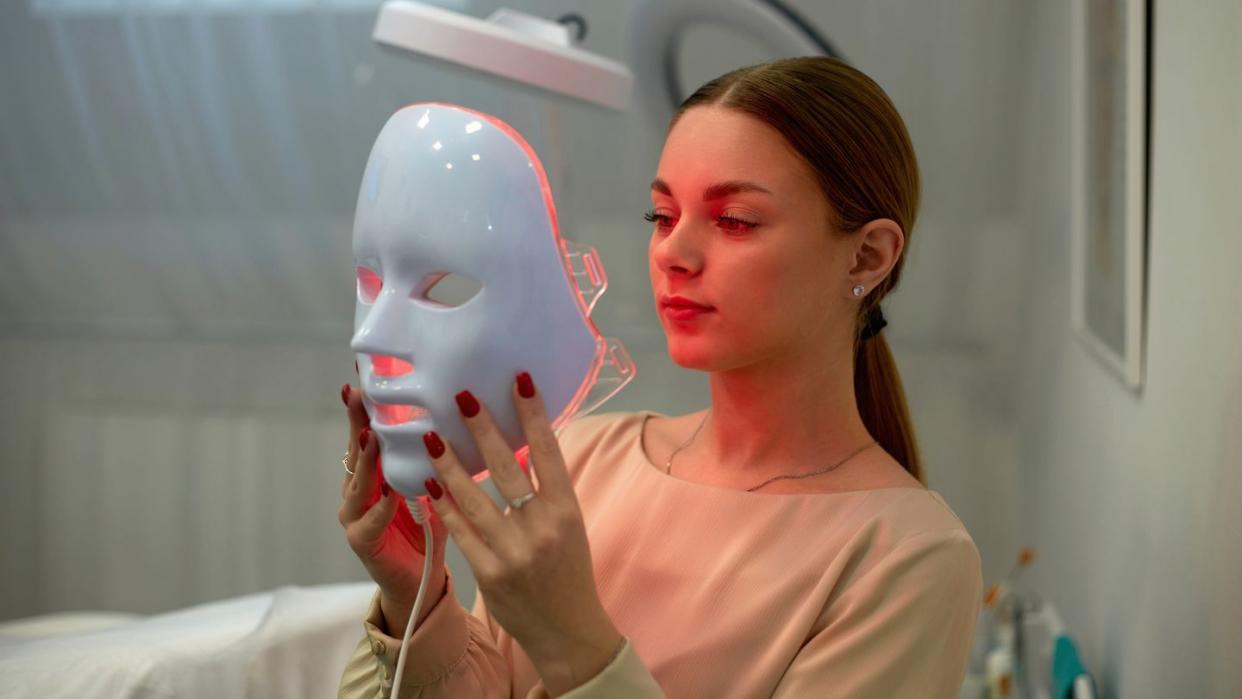Should You Use a Red Light Therapy Device? Here's What an Expert Says About the Treatment's Benefits and Risks

"Hearst Magazines and Yahoo may earn commission or revenue on some items through these links."
Whether you've seen it light up your TikTok feed or heard it touted by beauty experts, red light therapy is one of today's biggest topical trends. Red light therapy is a skincare treatment that uses low-level wavelengths of red and near-infrared light to help heal and treat several skin concerns, according to Healthline. It’s also known as low-level light therapy, soft laser therapy, and cold laser therapy.
Many brands claim that their at-home light therapy devices can help soothe muscles, quell inflammation, reduce acne, and enhance your complexion, but are they too good to be true? We talked to a celebrity esthetician and skincare expert all about the benefits and potential risks of red light therapy — read on to learn more.
What Are the Benefits of Red Light Therapy?
It may be anti-inflammatory
While blue light is often used to disinfect and kill bacteria, red light therapy is much more gentle on the skin and may help to lower inflammation. This is great for those who frequently experience irritation when using other skincare products.
“Red light is considered to be great for sensitive skin and aging,” says Nina Avakyan, the lead esthetician of World Spa in Brooklyn, New York. “When inflamed adult acne appears, red light helps to reduce and calm the skin.”
It may soothe and relax muscles
Because red light therapy may help to quell inflammation, it may also soothe and relax sore muscles.
“Infrared light is soothing,” Avakyan says. “So, when people have clenched jaws, this is one of the best treatments because it helps with stiffness in the area. It also has a similar effect on joints.”
The process is quick and easy
Just as with adding any other skincare product to your routine, you have to use red light therapy on a regular schedule for the best chance in seeing results. While the process is quick and simple to do, if the issue you're treating is persistent, you'll need to remember to do it often.
“If the person wants to treat something chronic, like stiffness, it has to be done a few times a week. It's almost like massage therapy,” Avakyan says.
It may enhance complexion
Because red light therapy is gentle and may be anti-inflammatory, it may also help repair skin damage and clear up blemishes without the use of more potent treatments.
“People with rosacea and broken capillaries cannot really use deep pressure massages. We could use infrared instead, and it will give the same results — which is relieving pain and helping the skin appear more toned, lifted, and glowing,” Avakyan said.
Is Red Light Therapy Safe to Use at Home?
Red light therapy is a popular spa treatment, but there are also lots of at-home products and brands to choose from. The one tip Avakyan gives to her clients is to only trust reputable brands (LightStim and HigherDOSE are two of her favorites).
If you're concerned about using red light therapy because of a health condition, you should talk to your doctor first.
What Are the Risks of Red Light Therapy?
While red light therapy is relatively safe, it's smart to be cautious when starting to use it. According to Healthline, using a red light therapy device may result in burns or blisters if it's making contact with the skin for longer than 30 minutes.
Avakyan also recommends against using a device from a no-name brand because “it either can be not as effective or dangerous, because we don't know where this machine came from.” It's also important to avoid red light therapy and infrared saunas after a procedure like pro-cell therapy or dermaplaning.
“After those treatments, I don't recommend doing any saunas, because we don't want to produce bacteria on the face,” Avakyan says.
You Might Also Like

